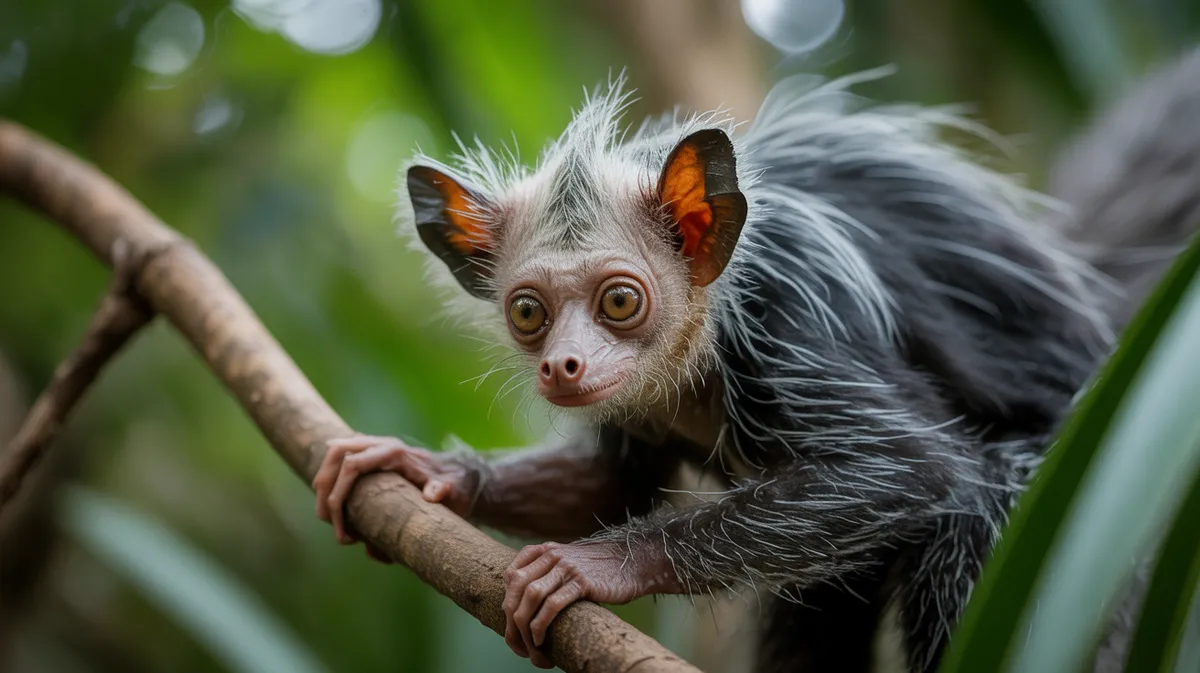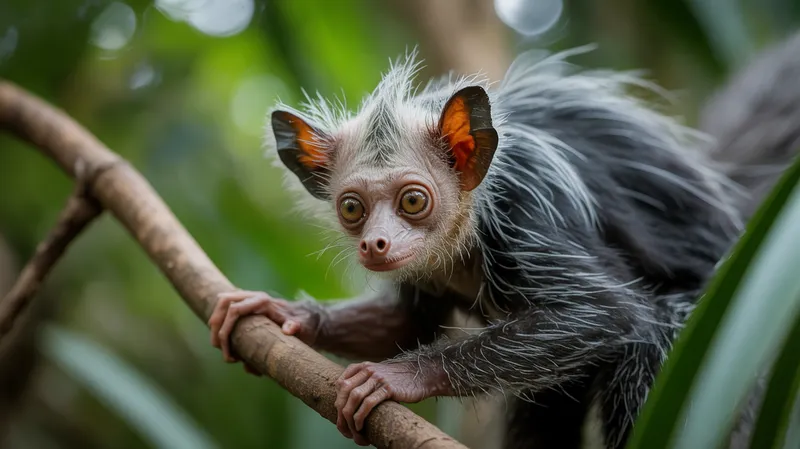
Aye-aye
Daubentonia madagascariensis

Meet the Aye-aye
The aye-aye is a unique nocturnal primate native to the rainforests of Madagascar. It is distinguished by its large eyes, bushy tail, and especially its elongated, thin middle finger, which it uses to tap on wood and extract insects—a method called percussive foraging. With rodent-like incisors that grow continuously, the aye-aye gnaws into wood to access insect larvae, making it the only primate known to use echolocation-like techniques for finding food. Despite its unusual appearance, the aye-aye plays a crucial ecological role in controlling insect populations. Its secretive and solitary lifestyle, combined with habitat loss, has contributed to its rarity and threatened status.
Classification
Mammal
Habitat
Tropical rainforest
Diet
Omnivore
Lifespan
10–23 years
Conservation
Endangered
Weight
2–2.8 kg
📖Fascinating Facts
Nocturnal Forager
The aye-aye is primarily active at night, using its large eyes and keen sense of hearing to locate prey in the dark.
Unusual Finger
Its extremely long, thin middle finger acts like a probe, allowing it to fish insect larvae out of tree bark and crevices.
Ecosystem Role
By feeding on wood-boring larvae, aye-ayes help limit pest populations and contribute to the health of Madagascar's forests.
📋Detailed Description
The aye-aye (Daubentonia madagascariensis) is a highly specialized nocturnal primate endemic to Madagascar, and the sole extant representative of the family Daubentoniidae. Adults typically weigh between 2 and 2.7 kg and measure 30–40 cm in body length, with a bushy tail that can reach up to 60 cm—often longer than the body itself. Its most distinctive anatomical feature is the extremely elongated and thin third finger, which is used for percussive foraging: the aye-aye taps on wood to locate hollow chambers containing insect larvae, then gnaws holes with its continuously growing, chisel-like incisors, and finally inserts its flexible finger to extract prey. The aye-aye has large, forward-facing eyes adapted for nocturnal vision, and prominent, mobile ears that aid in detecting the movement of larvae within wood. Its dense, shaggy fur is dark brown to black, often with white guard hairs, providing camouflage in the forest canopy. The species is arboreal and highly agile, moving through the trees using a combination of quadrupedal locomotion and leaping. Solitary by nature, aye-ayes maintain large home ranges, with minimal overlap between individuals except during the breeding season. Their omnivorous diet includes insect larvae, fruit, seeds, nectar, and fungi, making them important seed dispersers and regulators of insect populations. The aye-aye's unique adaptations and secretive lifestyle have made it a subject of fascination and superstition in Malagasy culture.
💡 Did you know?
Some local legends in Madagascar consider the aye-aye an omen of bad luck, leading to it being persecuted in some areas.
🔬Research & Sources
Wikipedia Summary
The aye-aye is a long-fingered lemur, a strepsirrhine primate native to Madagascar with rodent-like teeth that perpetually grow and a special thin middle finger that they can use to catch grubs and larvae out of tree trunks.
Last Modified: 5/24/2025
🎭Behavior & Social Structure
Aye-ayes are strictly nocturnal, emerging from their nests at dusk to forage throughout the night. They exhibit solitary behavior, with individuals occupying overlapping home ranges of up to 80 hectares for males and 30–40 hectares for females. Foraging is characterized by a distinctive sequence: the aye-aye uses its elongated middle finger to tap rapidly on wood, listening for changes in resonance that indicate the presence of hollow chambers. Once prey is detected, the animal gnaws a hole with its incisors and uses the same finger to extract larvae or grubs. This percussive foraging is unique among primates and is functionally analogous to the woodpecker's feeding strategy. Aye-ayes also consume a variety of plant materials, including coconuts, mangoes, and can even extract the pulp from unripe fruit using their incisors and fingers. They build spherical nests of leaves and twigs in the fork of large trees, which serve as daytime resting sites. Social interactions are limited, but vocalizations, scent marking, and occasional encounters at feeding sites occur, especially during the breeding season.
👶Reproduction & Life Cycle
Aye-ayes are thought to be polygynous, with males competing for access to receptive females. Breeding can occur year-round, but peaks have been observed from February to September. Females exhibit estrus for only a few days, during which they vocalize and scent-mark to attract mates. After mating, gestation lasts approximately 150–170 days. Females give birth to a single offspring, which is altricial and remains in the nest for the first two months of life. Maternal care is pronounced: the mother nurses and grooms the infant, and carries it between nests as needed. Weaning occurs at around 7 months, but juveniles may remain with the mother for up to two years before becoming fully independent. Sexual maturity is reached at 2.5–3.5 years for females and slightly later for males. The interbirth interval is typically two to three years, reflecting the high investment in each offspring.
🛡️Adaptations & Survival
The aye-aye's most remarkable adaptation is its specialized third digit, which is thin, highly flexible, and equipped with a ball-and-socket joint, allowing for independent movement. This adaptation, combined with acute auditory sensitivity and continuously growing incisors, enables efficient percussive foraging. The animal's large eyes are adapted for low-light vision, while its mobile, bat-like ears facilitate precise localization of prey within wood. Its dentition is unique among primates, with incisors that grow throughout life—an adaptation convergent with rodents. The aye-aye's cryptic coloration and nocturnal habits help avoid predation. Its arboreal lifestyle is supported by strong limbs and a prehensile tail, which aids in balance and movement through the canopy. Behaviorally, the aye-aye exhibits flexible foraging strategies, capable of exploiting a wide range of food resources, which is key to its survival in fragmented habitats.
📚Research Sources
🎨Cultural Significance
In Malagasy folklore, the aye-aye is often regarded as an omen of ill fortune or death, largely due to its unusual appearance and nocturnal habits. Some communities believe that an aye-aye seen near a village foretells misfortune, and the animal is sometimes killed on sight to ward off perceived evil. This cultural stigma has contributed to its rarity outside protected areas. However, the aye-aye also features in local stories as a trickster figure, and in recent years, conservation organizations have worked to shift perceptions by highlighting its ecological importance and uniqueness. There are no known traditional uses of aye-aye body parts, but its symbolic role in Malagasy culture is significant and influences conservation outcomes.
🔬Recent Research & Discoveries
Recent research has focused on the aye-aye's genomic adaptations, revealing unique genes associated with its specialized dentition and sensory systems. Studies using radio telemetry and camera traps have provided new insights into home range size, nest use, and movement patterns. Ongoing research is investigating the impact of habitat fragmentation on genetic diversity, with some evidence of inbreeding in isolated populations. Conservation genetics projects are underway to inform translocation and reintroduction efforts. Additionally, studies of aye-aye vocalizations and social interactions are shedding light on the species' communication and mating systems. The aye-aye's role as a model for convergent evolution (with woodpeckers and rodents) continues to attract scientific interest.
🎥Wildlife Videos

The Demon Primate | World's Weirdest
#NatGeoWILD #WorldsWeirdest #Lemurs About World's Weirdest: A buffalo with three eyes, an exterminator who eats his day's ...
Nat Geo Animals

Discovering the Aye-aye
Discover the Aye-Aye: Did You Know? Amazing Animal Facts Ever heard of an aye-aye? This nocturnal lemur from Madagascar is ...
Nat Geo Wilder

Aye Aye | animal documentary
Aye Aye | animal documentary The Aye Aye, one of the most fascinating and strange primates in the world, is the star of this ...
Cityanimal EN

Aye Aye: The Harbinger of Death
The Aye Aye is a lemur that is doing everything its power to convince people it's not a lemur. Special thanks to the Cincinnati Zoo.
Animalogic

Brian Cox Meets an Aye-Aye | Wonders of Life | BBC Earth
Professor Brian Cox gets a rare and up-close look at a sedated aye-aye, known for it's unusual way of hunting for food. Taken from ...
BBC Earth

Aye-Aye | A Wonder from Madagascar
This video is about aye-aye the wonder from Madagascar. They are very small in size and they have very special way to find a ...
Nature’s wonders
🌍Habitat Information
The Aye-aye typically inhabits Tropical rainforest environments. Aye-ayes have adapted to their environments with specialized features and behaviors.
Primary Habitat:
Tropical rainforest
More detailed habitat information will be available soon.
🛡️Conservation Status
The Aye-aye is currently classified as Endangered. Conservation efforts are crucial for preserving this species for future generations.
Common Threats:
- 🏠Habitat loss and fragmentation
- 🌡️Climate change impacts
- 🎯Hunting and poaching
- 🏭Human-wildlife conflict
⚠️Threats & Conservation Challenges
The aye-aye is classified as Endangered by the IUCN due to ongoing habitat loss, fragmentation, and persecution by humans. Madagascar's forests are being rapidly cleared for agriculture, logging, and charcoal production, reducing available habitat and isolating populations. Additionally, local superstitions often associate the aye-aye with bad luck or death, leading to intentional killing. Low reproductive rates and large home range requirements further exacerbate vulnerability. While some populations persist in protected areas, illegal hunting and habitat encroachment remain significant threats. Recent population estimates suggest a continuing decline, with the species now absent from much of its historical range. Conservation efforts focus on habitat protection, community education, and research into population dynamics and genetics.
🔬Scientific Classification
Scientific Name
Daubentonia madagascariensis
Classification Hierarchy
🔍 About Taxonomic Classification
Taxonomic classification is a hierarchical system used by scientists to classify and organize living organisms based on shared characteristics and evolutionary relationships.
The system moves from broad categories (Kingdom) to increasingly specific ones, with each animal's scientific name typically consisting of its Genus and species.
📝Community Notes
Share your observations and insights about the Aye-aye with our community of wildlife enthusiasts.
Join Our Community
Sign in to share your observations and connect with fellow wildlife enthusiasts.
Sign In to ContributeNo community notes yet
Be the first to share your observations about the Aye-aye!
Explore Aye-aye
Select a tab above to learn more about this amazing animal.
📸Photo Gallery
No photos available for this animal yet.
🌟Discover More Wildlife
Continue your journey of discovery with more fascinating animals from our database
